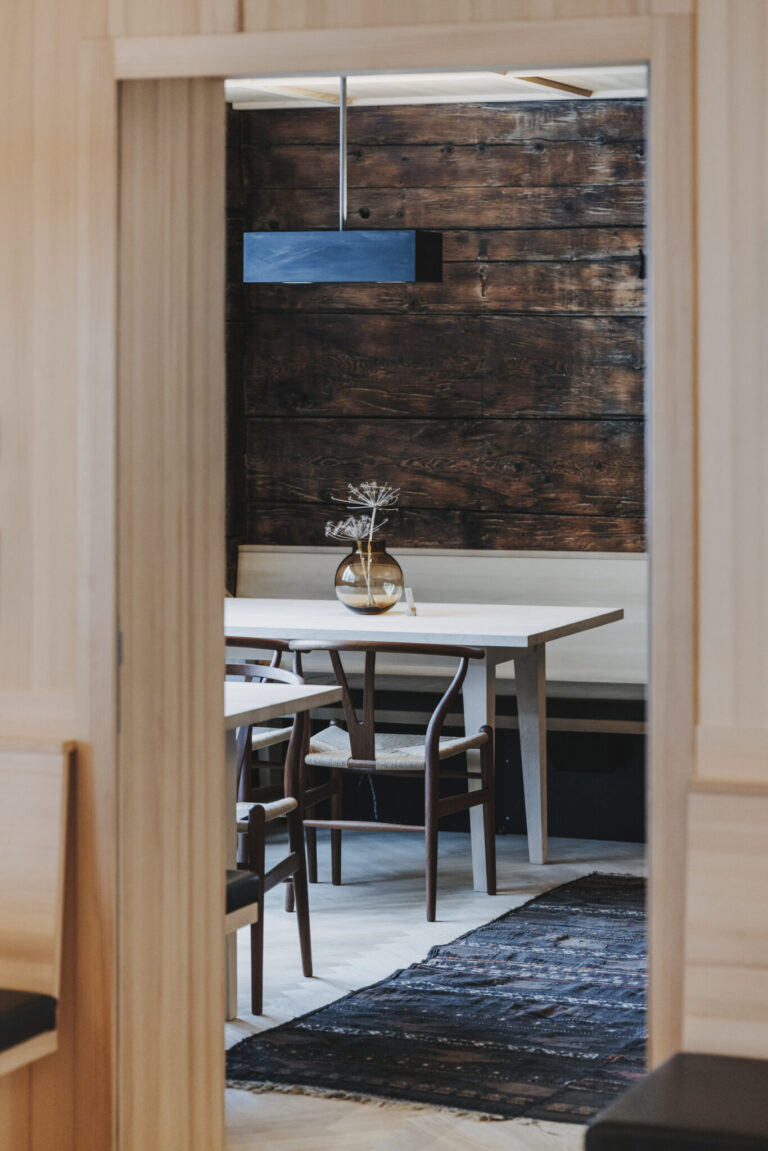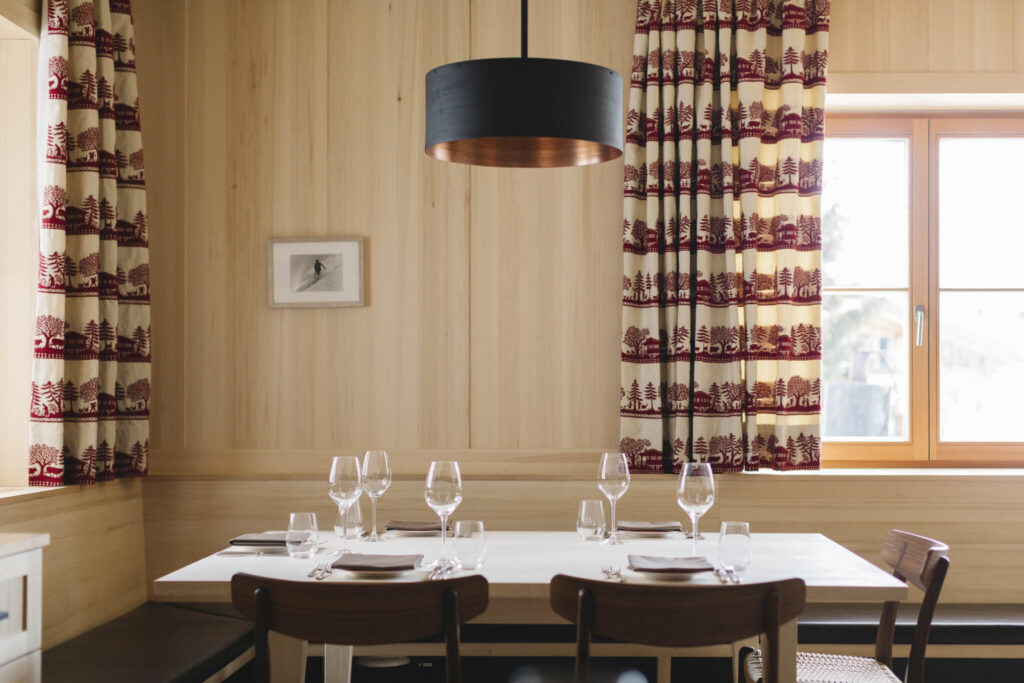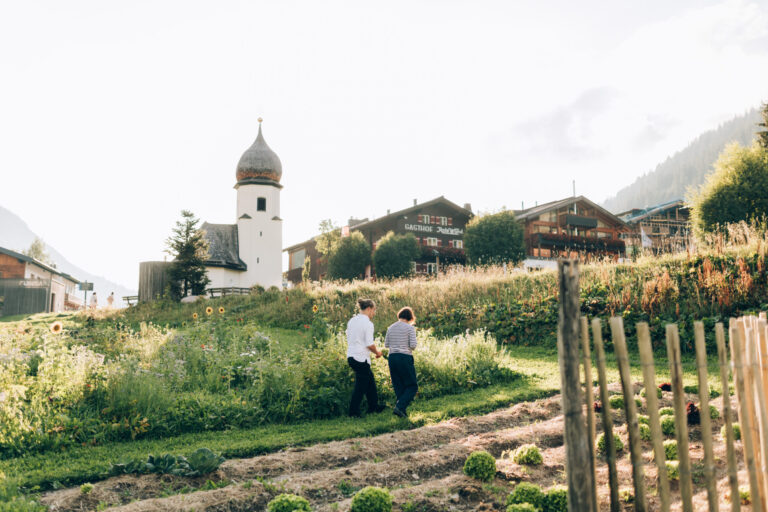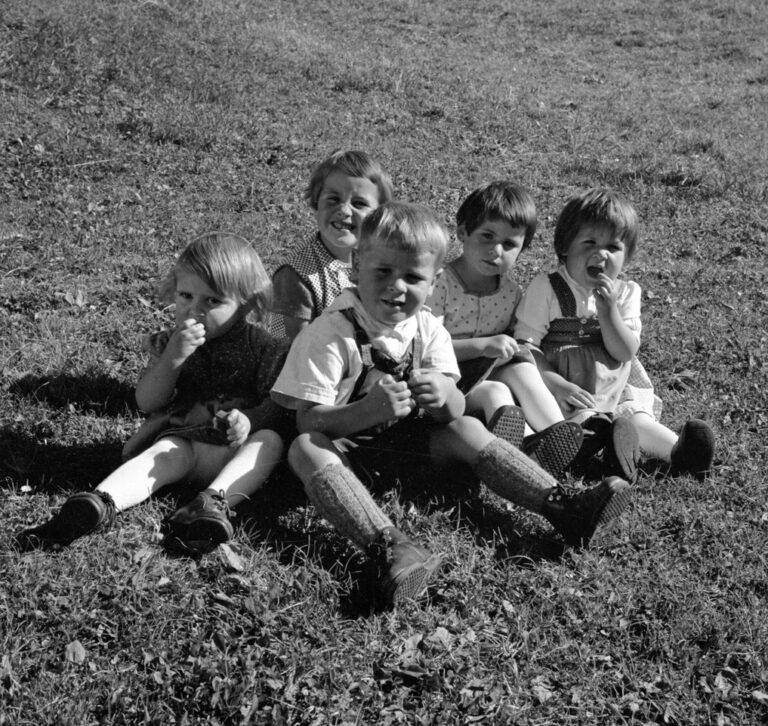The light manufactory of a special kind
The Hotel Rote Wand has a lot of unique and handmade lights from the light factory Halotech. We talked to Ernst Mitterndorfer about lighting concepts, craftsmanship, curious customers and constructive cooperation.
The Rote Wand loves the lighting technology. What is the concept behind it?
As in all our projects, we have developed the light and the luminaires specifically for the spatial conditions and the special character of the house. It was important to me that the unobtrusive luxury and high design standards of the Rote Wand were also reflected in the lighting concept. The luminaire at the buffet, for example – it is basically a simple and unadorned thing, but I think it corresponds exactly to the objectivity and clear optics that are needed there. In the restaurant you want to create the ideal atmosphere for eating together – the tables are illuminated like theatre stages and the people around them sit in the soft, gentle reflection of this light. So we take a close look at each zone of the house and react to it, both in terms of form and lighting technology. In other words, the appearance and use of the room have a direct influence on the appearance of the respective luminaires. When the client then says: “I like the luminaires in the restaurant, above the tables, but in the old parlours I want to have something different!” I am pleased that Joschi Walch has a good feeling for design and atmosphere. I like to work with such impulses.
In some rooms the lights have the value of a better car. How do you make this clear to your customers? What’s so special about it?
The special thing about our lighting concepts is that they are tailor-made from start to finish. Like a handmade shoe. First the foot is looked at, a last is made especially for this foot, the material is selected and then a craftsman produces an object in perfection and in a reasonable time that fits like a glove. It is comfortable and lasts almost forever; and it is also easy to repair. This process of thinking and working that is inside the thing is something you feel and enjoy every day, I am convinced of that. That’s what we want for our lamps, too.
Of course, in a way it’s a luxury, that’s true. But not as it is generally understood by luxury fashion brands. We want to create a value that results from the design process and the quality of the product, not from an image or a brand. We want to appeal to customers who understand and value such demands and who also want to deal with the subject matter. If you go along with them, you will also gain the understanding and willingness to spend money on the lights.


A specific product for a very specific target group. – Who are your customers and what does an ideal collaboration look like to you?
The customers who come to us are sensitive to their environment and the architecture that surrounds them. In many cases, contact with me is established through the architects and this usually results in a very constructive dialogue. You challenge me and I try to find solutions, this cooperation often results in an unexpected added value that everyone enjoys. I also like it a lot when the builders get involved, when they ask questions and don’t let up. I often work with clients and architects over many years – this process, the stories behind it and the personal relationship, that’s what I like. When everything is successful, the light is a logical part of the design concept of a house or room. I am thinking here of the time of Adolf Loos and Josef Hoffmann and their idea of the Gesamtkunstwerk; where everything from the room, the furniture, the crockery to the textiles was designed as a coherent unit. That would be my ideal. And to answer the question pragmatically: We develop lighting concepts for a wide variety of customers and uses – from hotels, restaurants, wine cellars to apartments, museums, shops and even outdoor zones such as public squares. Most of our projects are located in German-speaking countries and northern Italy.
Why do you work with light? How was HALOTECH created?
I came to the light by chance, it wasn’t actually planned. After studying architecture in Innsbruck, I ended up working for the Bartenbach lighting laboratory, probably the most important lighting planner at the time. The odd job finally turned into a year and a half and it was an incredibly exciting time. It was almost like a university or a research laboratory, with interdisciplinary teams and a lot of colourful birds. I, as a young student, suddenly built models for Norman Foster or Zaha Hadid! That’s how I came to the light and then joined the Halotech company. I have been running it since 1997.
Why do I work with light? I have learned how much you can achieve with it. The room becomes a different one with good or bad light! Light creates atmosphere and you can consciously design with it, I find that fascinating. How do I set the room in scene, what do I get out of it or let it step into the background? Do I want a direct light that shines like the sun, or should it rather correspond to the overcast sky? Then there are hardly any disturbing shadows, but everything is bland, there is no brilliance. For plasticity and liveliness I need direct light again. So on the one hand there is the creative freedom, but then there is also a right and wrong in the light planning; and here we want to do as much as possible right.

Can you tell us something about the manufacturing process of the luminaires? What are the production steps and what do you attach particular importance to? – Material, aesthetics, craftsmanship?
The conception and planning are a very essential part of the development for us and accordingly complex and intensive. I have already mentioned this above. The formal decision as to what a luminaire looks like is always made in parallel with the lighting concept and here we are approaching the ideal idea more and more through sketches, drafts and models. The construction plan is then developed from this – each luminaire is a unique piece. Over the years, HALOTECH has developed a certain formal language: reduced, clear, geometric, rather minimalist. This corresponds to us, but from time to time we also allow ourselves an outburst into the, well, expressive. One time it was a huge chandelier with hanging glass rods for an entrance portal in Vienna, or another time we organically deformed a translucent artificial stone material under heat and installed the illuminants in it. It’s exciting to remain formally true to yourself.
Then we go on to the execution of the lights in our workshop. It’s great when you can do as much as possible yourself in the house – edging, welding, milling, everything. This makes us flexible, fast and independent of quantities. In terms of material, we mainly work with metal – aluminium, steel, brass, copper, rare bronze and, quite rarely, titanium or precious metals. Whenever possible, we try to leave the material pure, not to paint, anodize or the like, these are chemically rather toxic processes and it is not necessary at all. The perfection in the craftsmanship must fit one hundred percent and if you then get something special out of the material, it’s a pleasure.
Is there something you are particularly proud of?
I am proud that we take the subject very seriously. We try to deal with every task in such a way that in the end the feeling arises that we have given the best – in the sense of the client, the architect, but also in our sense. We consider the small luminaire above the private kitchen table just as important as the lighting of an entire museum. We have been working intensively on lighting technology for thirty years. The know-how has grown through experience. In a conversation with architectural photographer Margherita Spiluttini, I once told her that I had broken off my architectural studies and came to light by chance. Then she – who is also not a trained photographer – said: “Ah, also a dilettante. These are the best! You have to prove yourself all the more and kneel down and get behind it. My claim is: an honest confrontation with the matter, doing something “decent” to the best of my knowledge and belief.


What do you see as your future challenges?
There are two aspects to this: from a global perspective, it is enormously challenging to survive in the long term in the existing economic system, where success is measured exclusively in terms of profit. There are the big players like Amazon, Google, Nestlé or Starbucks, who determine the world economy and can get away with anything according to the motto “too big to fail”. These are negative examples for me and I feel directly affected by them. If I were to work according to their logic, I would buy the individual parts in China at half the price. But I would like to work precisely against the concept of disposable products, with the approach of regional, handcrafted high quality. The fact that this basically makes you the economic loser annoys me. Something has gotten out of hand over decades that can hardly be put right now – or only by a countermovement by the great mass of the population. And if I relate the question to my concrete work, my challenge is: to keep developing something new out of what already exists. I want to use materials more and more consistently and naturally, to use fewer and fewer chemical processes, to work sensibly with new technologies. A simple principle: try something new every day and do it even better than the last time!
Mr. Mitterndorfer, thank you very much for the nice talk!





